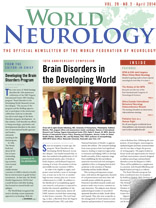By John D. England, MD

John D. England
The Journal of the Neurological Sciences (JNS) and its publisher, Elsevier, are working together to improve the journal and to make the submission process easier for authors.
A major complaint from authors concerns the necessity to format manuscripts to fit the idiosyncratic requirements of journals. Since many high volume journals like JNS have a high rejection rate, authors frequently must reformat their manuscripts for submission to a different journal. This is not only a hassle, but a time-consuming process for authors.
In order to simplify the submission process for authors, JNS has eliminated strict requirements for reference formatting. As of now, we will accept manuscripts with no strict requirements for reference formatting. Any style of reference formatting will be accepted as long as the style is consistent.
If the manuscript is accepted for publication, then Elsevier will change the reference formatting to fit the style for JNS. As an extension of this process, in the near future JNS and Elsevier will begin accepting entire manuscripts without strict formatting or referencing requirements.
 Elsevier already has introduced this feature, which is named “Your Paper Your Way (YPYW),” for several other journals in its portfolio. It has been so well received by authors that we will shortly begin offering this service to authors of manuscripts submitted to JNS. Taken together, these new options for manuscript formatting flexibility should make it easier for authors to submit manuscripts to JNS.
Elsevier already has introduced this feature, which is named “Your Paper Your Way (YPYW),” for several other journals in its portfolio. It has been so well received by authors that we will shortly begin offering this service to authors of manuscripts submitted to JNS. Taken together, these new options for manuscript formatting flexibility should make it easier for authors to submit manuscripts to JNS.
As noted in the previous issue of World Neurology, we have begun an “Editor’s Selection” of articles from JNS. Elsevier has agreed to allow free access to selected articles for members of the World Federation of Neurology. The process for viewing these articles is now streamlined: Click on one of the two featured articles on the World Neurology Online page, or use the “See all free JNS articles” link below the featured articles. It will take you directly to the free article page on the JNS website. In this issue, we share these two recent articles:
The Clinical and Pathological Phenotypes of Frontotemporal Dementia with C9ORF72 Mutations. Ying Liu and others from China have written a review on the phenotypes of frontotemporal dementia associated with C9ORF72 mutations. The expanded hexanucleotide repeat (GGGGCC) in the chromosome 9 open reading frame 72 (C9ORF72) is now recognized as one of the major causes of hereditary frontotemporal dementia (FTD). It is also the most frequent genetic cause of the ALS/FTD complex. However, the clinical and pathological phenotypes associated with C9ORF72 mutations appear increasingly diverse, and the mechanisms of disease are not known. See Liu Y, et al.
Journal of the Neurological Sciences 335 (2013) 26-35. An Association Between Benzodiazepine Use and Occurrence of Benign Brain Tumors. Tomor Harnod and others analyzed data from the National Health Insurance System of Taiwan to ascertain whether there is an association between long-term benzodiazepine use and the development of brain tumors. They identified 62,186 patients who had been prescribed benzodiazepines for at least two months between Jan. 1, 2000, and Dec. 31, 2009. These patients were compared with a matched non-benzodiazepine cohort of 62,050 patients. The incidence rate for benign brain tumors was 3.33 times higher in the benzodiazepine cohort compared to the non-benzodiazepine cohort with an adjusted hazard ratio (HR) of 3.15 (95% CI = 2.37-4.20). Additionally, the adjusted HRs for benign brain tumors increased with benzodiazepine dose. Thus, in this cohort study, the authors found a significant association of benign brain tumors with long-term benzodiazepine use. There are many possible explanations for such an association, and the authors correctly avoid the conclusion of causation. But, benzodiazepines are a commonly prescribed medication, and further studies of this important topic are warranted. See Harnod T, et al.
Journal of the Neurological Sciences 336 (2014) 8-12.
